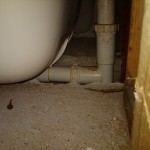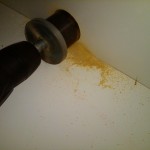We normally think of a termite invasion on the foundation walls but the bath traps give them the opportunity to surface well into the middle of any home that has not been treated and wreak havoc. In an earlier article I explained how to cut in a simple bath trap in a standard situation. Please feel free to follow the link for details on this simple trap and the ‘why’ a trap is necessary in the first place.
Difficult bath traps are becoming more common with fancier homes and more complex bathrooms. Garden tubs, space saving building
techniques, tiled walls, and built in cabinetry often block a clean way to cut in your trap. In some cases you just can’t install a trap and at that point you need to make a decision. Using a product like Termidor can make up for a lot of short comings so do you trust your foundation barrier to work its magic even on the termites that may be infesting the plumbing area? Do you drill into the slab where pipes lie waiting to shoot out like a geyser once punctured? You could try and drill a small hole through the tile or cabinet and foam the area which in my opinion is better than nothing, or if the bathroom is on an exterior wall there’s always the long rod technique. You may need to use some imagination but even in this era of less drilling the bath trap is just to much of a risk too let go untreated. The most important tool regardless of how you decide to proceed will be your measuring tape. Getting to the right spot the first time saves time but also reduces any undue marring of a wall your customer will see every day. Determine just where the bathtub plumbing goes through the slab ( that’s usually the drain ) and then pick a common spot that you can measure from on the other side of the wall. I measure from the inside edge of the exterior wall whenever possible but you could go from the door as long as the adjacent wall connects directly to the wall you’ll be cutting. ie; the door leads to the hall which leads to the living room and that wall runs parallel with the wall the tub sits up against. You may find that you’ll be cutting your trap in some unlikely spots and again, accuracy will be key to just needing one cut and one vent. Back to back bathrooms can be tricky and you’ll most likely need two cuts. If you can keep them close enough you can use one vent to cover them both.Always remember you are cutting and drilling into an area with soft pipes and you need to go lightly. Don’t ram that drill bit in or push the
knife through all at once. Do just a little at a time and slowly get through your surface. The best scenario would be to remove enough drywall to be able to peer inside this void. It may be that the pipes have been sealed with cement and you don’t need to treat at all. For tiled walls and using only a drill bit this won’t usually be available but still worth the effort. Studs can also block your access so make sure to knock on the wall a bit and see if you get a hollow sound so you know you’re clear. The days of whole house drilling are fading fast but I don’t envision the day where bath traps are something that any termite tech should ignore.







